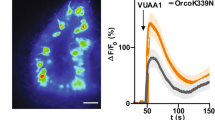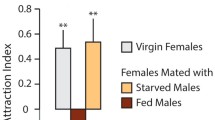Abstract
Male-female courtship interactions inDrosophila melanogaster are mediated in part by chemical cues. A comparison of the courtship behaviors of normal and genetically olfaction-deficient (olfD) flies lends strong support to this hypothesis and leads to the following inferences regarding the importance of chemical interchange during courtship. Virgin females respond to male courtship by slowing and finally stopping their movements, which appears to enhance the probability of copulation; (olfD) females are defective in this stopping response and in their receptivity to mating. Males can be stimulated to court by airborne cues from virgin females which are effective over a distance of ca. 5 mm. By comparison, the chemical courtship-stimulating cues from immature flies have little airborne efficacy; immature males appear to stimulate courtship only by contact chemoreception. The genetic upset or removal from courtship interactions of olfactory, visual, and auditory cues (thus leaving contact chemoreception as the probable major means of male-female interaction) results in virtual behavioral sterility.
Similar content being viewed by others
References
Aceves-Piña, E. O., and Quinn, W. G. (1979). Learning in normal and mutantDrosophila larvae.Science 206:93–96.
Averhoff, W. W. and Richardson, R. H. (1974). Pheromonal control of mating patterns inDrosophila melanogaster.Behav. Genet. 4:207–225.
Benzer, S. (1967). Behavioral mutants ofDrosophila isolated by counter-current distribution.Proc. Natl. Acad. Sci. USA 58:1112–1119.
Cook, R. (1980). The extent of visual control in the courtship tracking ofDrosophila melanogaster.Biol. Cybernet. 34:41–51.
Cook, R. (1981). Courtship-like tracking behavior in wild-type femaleDrosophila melanogaster.Z. Naturforsch 36:475–483.
Fuyama, Y. (1976). Behavior genetics of olfactory responses inDrosophila. I. Olfactometry and strain differences inDrosophila melanogaster.Behav. Genet.,6:407–420.
Gailey, D. A., Jackson, F. R., and Siegel, R. W. (1982). Male courtship inDrosophila: The conditioned response to immature males and its genetic control.Genetics 102:771–782.
Gailey, D. A., Hall, J. C., and Siegel, R. W. (1985). Reduced reproductive success for a conditioning mutant in experimental populations ofDrosophila melanogaster.Genetics 111:795–804.
Grossfield, J. (1986). The influence of light on the mating behavior ofDrosophila, Univ. Tex. Publ. 6615:147–176.
Hall, J. C. (1984). Complex brain and behavioral functions disrupted by mutations inDrosophila.Dev. Genet. 4:355–378.
Hall, J. C., Alahiotis, S. N., Strumpf, D., and White, K. (1980). Behavioral and biochemical defects in temperature-sensitive acetylcholinesterase mutants ofDrosophila melanogaster.Genetics 96:939–965.
Hotta, Y., and Benzer, S. (1976). Courtship inDrosophila mosaics: Sex-specific foci for sequential action patterns.Proc. Natl. Acad. Sci. USA 73:4154–4158.
Jallon, J.-M. (1984) A few chemical words exchanged byDrosophila during courtship and mating.Behav. Genet. 14:441–478.
Jallon, J.-M., and Hotta, Y. (1979). Genetic and behavioral studies of female sex appeal inDrosophila.Behav. Genet. 9:257–275.
Jallon, J.-M., and Hotta, Y. (1981). Nonchemical messages of the femaleDrosophila melanogaster. In Hotta, Y. (ed.),Genetic Dissection of Drosophila Behavior (Proceedings of the Seventh International Symposium, Division of Biophysics, The Taniguchi Foundation), University of Tokyo, Tokyo, Japan, pp. 136–144.
Lefevre, G., Jr., and Johnson, T. (1973). Evidence for a sex-linked haplo-inviable locus in thecut-singed region ofDrosophila melanogaster, Genetics 74:633–645.
Lindsley, D., and Grell, R. (1968). Genetic variations ofDrosophila melanogaster. Carnegie Inst. Wash. Publ. 627.
Manning, A. (1967). The control of sexual receptivity in femaleDrosophila.Anim. Behav. 15:239–250.
Markow, T. A., and Hanson, S. J. (1981). Multivariate analysis ofDrosophila courtship.Proc. Natl. Acad. Sci. USA 78:430–434.
McEwen, R. S. (1918). The reactions to light and gravity inDrosophila and its mutants.J. Exp. Zool. 25:49–106.
Meyerowitz, E. M., and Kankel, D. R. (1978). A genetic analysis of visual system development inDrosophila melanogaster.Dev. Biol. 62:112–142.
Pak, W. L. (1979). Study of photoreceptor function usingDrosophila mutants In Breakefied, X. O. (ed.),Neurogenetics: Genetic Approaches to the Nervous System, Elsevier, New York, pp. 67–99.
Pinsker, W., and Doschek, E. (1979). On the role of light in the mating behavior ofDrosophila subobscura.Z. Naturforsch. 34c:1253–1260.
Quinn, W. G., and Greenspan, R. J. (1984). Learning and courtship inDrosophila: Two stories with mutants.Annu. Rev. Neurosci. 7:67–93.
Robertson, H. M. (1983). Chemical stimuli eliciting courtship by males inDrosophila melanogaster.Experientia 39:333–335.
Rodrigues, V. (1980). Olfactory behavior ofDrosophila melanogaster In Siddiqi, O., Babu, P., Hall, L. M., and Hall, J. C. (eds.)The Development and Neurobiology of Drosophilia, Plenum, New York, pp. 361–371.
Rodrigues, V., and Siddiqi, O. (1978). Genetic analysis of chemosensory pathway.Proc. Ind. Acad. Sci. 87B:147–160.
Schilcher, F. von (1976). The role of auditory stimuli in the courtship ofDrosophila melanogaster.Anim. Behav. 24:18–26.
Shorey, H. H., and Bartell, R. J. (1970). Role of a volatile female sex pheromone in stimulating male courtship behaviour inDrosophila melanogaster.,Anim. Behav. 18:159–164.
Siddiqi, O. (1984). Olfactory neurogenetics ofDrosophila. In Chopra, V. L., Sharma, R. P., Joshi, B. C., and Bansal, H. C. (eds.),Genetics: New Frontiers, Volume III (Proceedings of XV International Congress of Genetics, December 1983), Oxford and IBI, New Delhi, India, pp. 243–261.
Siegel, R. W., and Hall, J. C. (1979). Conditioned responses in courtship behavior of normal and mutantDrosophila.Proc. Natl. Acad. Sci. USA 76:3430–3434.
Siegel, R. W., Hall, J. C., Gailey, D. A., and Kyriacou, C. P. (1984). Genetic elements of courtship inDrosophila: Mosaics and learning mutantsBehav. Genet. 14:383–410.
Spieth, H. T. (1952). Mating behavior within the genus,Drosophila (Diptera).Bull. Am. Mus. Nat. Hist. 99:385–474.
Spieth, H. T. (1974). Courtship behavior inDrosophila.Annu. Rev. Entomol. 19:383–406.
Tompkins, L. (1984). Genetic analysis of sex appeal inDrosophila.Behav. Genet. 14:411–440.
Tompkins, L., Hall, J. C., and Hall, L. M. (1980). Courtship stimulating volatile compounds from normal and mutantDrosophila.J. Insect Physiol. 26:689–697.
Tompkins, L., Gross, A., Hall, J. C., Gailey, D. A., and Siegel, R. W. (1982). The role of female movement in the sexual behavior ofDrosophila melanogaster.Behav. Genet. 12:295–307.
Tompkins, L., Siegel, R. W., Gailey, D. A., and Hall, J. C. (1983). Conditioned courtship inDrosophila and its mediation by association of chemical cues.Behav. Genet. 13:565–578.
Venard, R., and Jallon, J.-M. (1980). Evidence for an aphrodisiac pheromone of femaleDrosophila.Experientia 36:211–212.
Zawistowski, S., and Richmond, R. C. (1985). Experience-mediated courship reduction and competition for mates by maleDrosophila melanogaster.Behav. Genet. 15:561–569.
Author information
Authors and Affiliations
Additional information
This work was supported by Grant GM-21473 from the NIH to J. C. Hall.
Rights and permissions
About this article
Cite this article
Gailey, D.A., Lacaillade, R.C. & Hall, J.C. Chemosensory elements of courtship in normal and mutant, olfaction-deficientDrosophila melanogaster . Behav Genet 16, 375–405 (1986). https://doi.org/10.1007/BF01071319
Received:
Accepted:
Issue Date:
DOI: https://doi.org/10.1007/BF01071319




